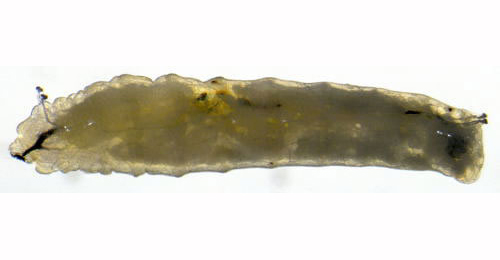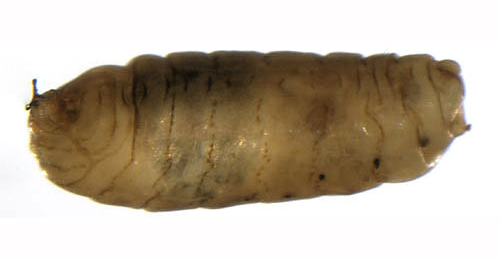|
||||||
|
MELICA. Slough-grasses. [Poaceae] |
|
Four species of Melica are recorded in Britain. These include the native Mountain Melick (M. nutans) and the Wood Melick (M. uniflora). Thirteen British miners are recorded on Melica. Nearly 100 British miners or possible miners are recorded on grasses in Britain. A key to the European miners recorded on Melica is provided in Bladmineerders van Europa. It is recommended that adults of all miners on grasses be reared to be certain of their identity. |
|
Key for the identification of the known mines of British |
1# > Leaf-miner: Details unknown. Probably the larva mines for a few days only, and afterwards lives as a stem borer. |
|
Ochsenheimeria urella Fischer von Röslerstamm, 1842 [Lepidoptera: Ypsolophidae]. |
1a > Leaf-miner: Tufted hair-grass and blue moor-grass are the main foodplants, the larvae forming gallery mines. Gradually widening corridor, running either upwards or down. All frass is deposited in the earliest part of the mine. Often 2-3 larvae in a mine; in grasses with broad leaves sometimes more than one mine in a leaf. |
|
Elachista adscitella Stainton, 1851 [Lepidoptera: Elachistidae]. |
1b > Leaf-miner: Corridor, 15 cm in the end, descending from the leaf tip. The mine is whtish and shallow at first, then becomes deeper, yellowish white, and more transparant. Pupation external; pupa, not in a cocoon, attached to the leaf. |
|
Elachista albidella Nylander, 1848 [Lepidoptera: Elachistidae]. |
1c > Leaf-miner: Corridor widening while descending from the tip of the leaf. The mine is unusual because the sides are very irregularly scalloped out. Moreover, the mine is not evenly transparent, but rather yellowish green and motly, because the larva leaves patches of parenchyma uneaten, and does not feed full depth. Frass in a few irregular, interrupted length lines. Often 2-3 larvae in a mine. The larvae hibernate in the centre of the mine; after winter they leave their mine and pupate. |
|
Elachista apicipunctella Stainton, 1849 [Lepidoptera: Elachistidae]. |
1d > Leaf-miner: Like related species, the larva mines blades of grass, in this case usually Cock's-foot, forming a thin whitish mine. The larva begins in autumn the making of a long, narrow, corridor with a fine central line of grey frass. The corridor is straight or lightly wavy, and descends into the leaf sheath, or even into the stem or rootstock. The larva regularly leaves the mine to begin making a new one. Pupation external. |
|
Elachista atricomella Stainton, 1849 [Lepidoptera: Elachistidae]. |
1e > Leaf-miner: Mine generally descending from the leaf tip. The mine may occupy the space between leaf margin and midrib, but may also occupy the entire width of the leaf. Most frass accumulated in the oldest part of the mine. Pupation external; the pupa is attached to the leaf without a cocoon. Larval head and prothoracic shield dark brown, ody yellowish white, with a pair of orange red latero-dorsal length lines; ventrally another such line, medially. |
|
Elachista cinereopunctella (Haworth, 1828) [Lepidoptera: Elachistidae]. |
1f > Leaf-miner: The larva mines downwards and forms an irregular mine with a silken tube in the centre, which is mixed with frass. Mine transparent (therefore conspicuous), generally descending from the leaf tip. Over the entire length of the mine stretches a central silken tube, in which the larva can retreat and can move quickly up or down. The tube also contains the frass. The larva feeds laterally from the tube, which makes the sides of the mine very irregular. |
|
Elachista gangabella Zeller, 1850 [Lepidoptera: Elachistidae]. |
1g > Leaf-miner: Long, narrow, white corridor, descending from close to the leaf tip to the leaf base or even stem. Frass in an inconspicuous grey line. From the stem the larva may enter a new leaf (Steuer, 1987a; Bland, 1996a). |
|
Elachista luticomella Zeller, 1839 [Lepidoptera: Coleophoridae]. |
1h > Leaf-miner: Initially a narrow brownish mine with blackish frass at its base, then moves to another leaf, forming a broader mine. Both mines can pucker the blade. |
|
Elachista obliquella Stainton, 1858 [Lepidoptera: Elachistidae]. |
1i > Leaf-miner: The larva creates a long narrow mine in the blade. Mine fairly translucent. It starts as a narrow corridor, running towards the leaf tip, but this almost invariably is overrun be a later, broad, descending corridor. The centre of the mine contains a vertical tube made of loose silk, in which the larva can quickly move up or down, and in which also most frass gets trapped. The sides of the mine are smooth (contrary to E. gangabella). Mines are difficult to find, because the leaves are wilting when larvae are present. |
|
Elachista subalbidella Schläger, 1847 [Lepidoptera: Elachistidae]. |
1j > Leaf-miner: Broad elongated mine; the form is dependent of the leaf form of the host plant. Frass green. Usually a number of larvae together in a mine. Pupation in the mine. |
|
Cerodontha incisa (Meigen, 1830) [Diptera: Agromyzidae]. |
1k > Leaf-miner: Normally several larvae feed together. Pupation in the mine (Spencer, 1976: 198). Broad elongated blotch. Frass greenish. Larvae generally communal. Pupation within the mine. The black puaria are individially anchored within the mine with a silken thread attached at their rear end. Distinguishable from C. incisa only by means of the larva. |
|
Cerodontha pygmaea (Meigen, 1830) [Diptera: Agromyzidae]. |
1l > Leaf-miner: Narrow whitish mine, with frass in distinct black lumps. Pupation internal (Spencer, 1976: 422). Whitish, upper-surface, descending corridor, about halfway up the blade. Frass in distinct black grains that are lying further apart than their diameter. Pupation in the mine. |
|
Chromatomyia fuscula (Zetterstedt, 1838) [Diptera: Agromyzidae]. |
1m > Leaf-miner: Long, narrow, whitish mine. Pupation internal (Spencer, 1976: 453); anterior spiracles projecting through the epidermis. Whitish, upper-surface, rather narrow corridor with comparatively large frass grains that are laying further apart than their diameter. Pupation within the mine. The anterior spiracles of the orange-brown puparium penetrate the epidermis. |
 Chromatomyia nigra larva, lateral Image: © Willem Ellis (Bladmineerders van Europa) |
 Chromatomyia nigra pupa, lateral Image: © Willem Ellis (Bladmineerders van Europa) |
|
Chromatomyia nigra (Meigen, 1830) [Diptera: Agromyzidae]. |
| Last updated 06-Jul-2019 Brian Pitkin | ||
